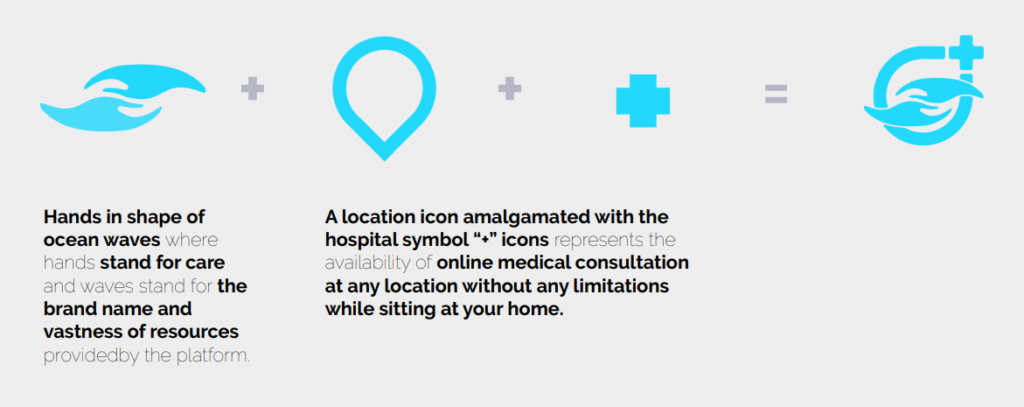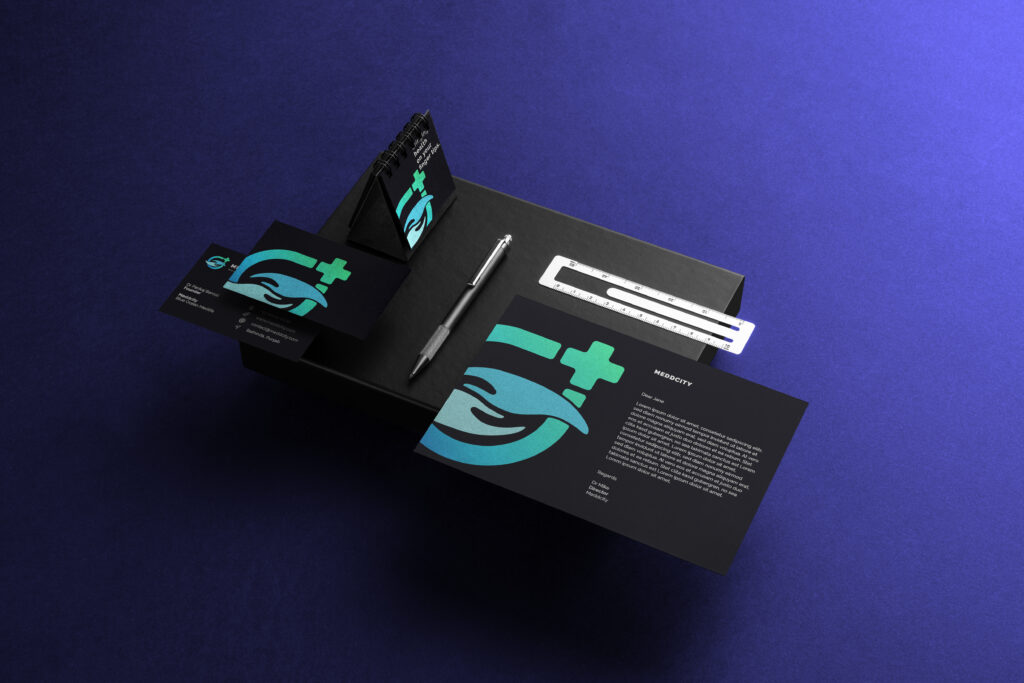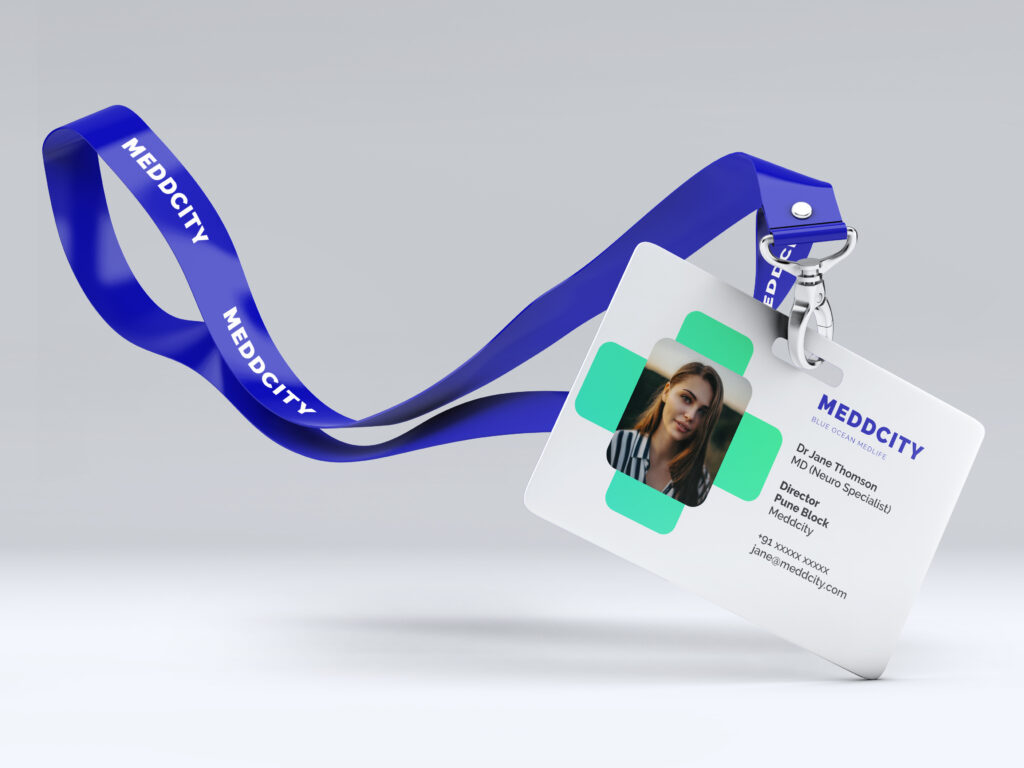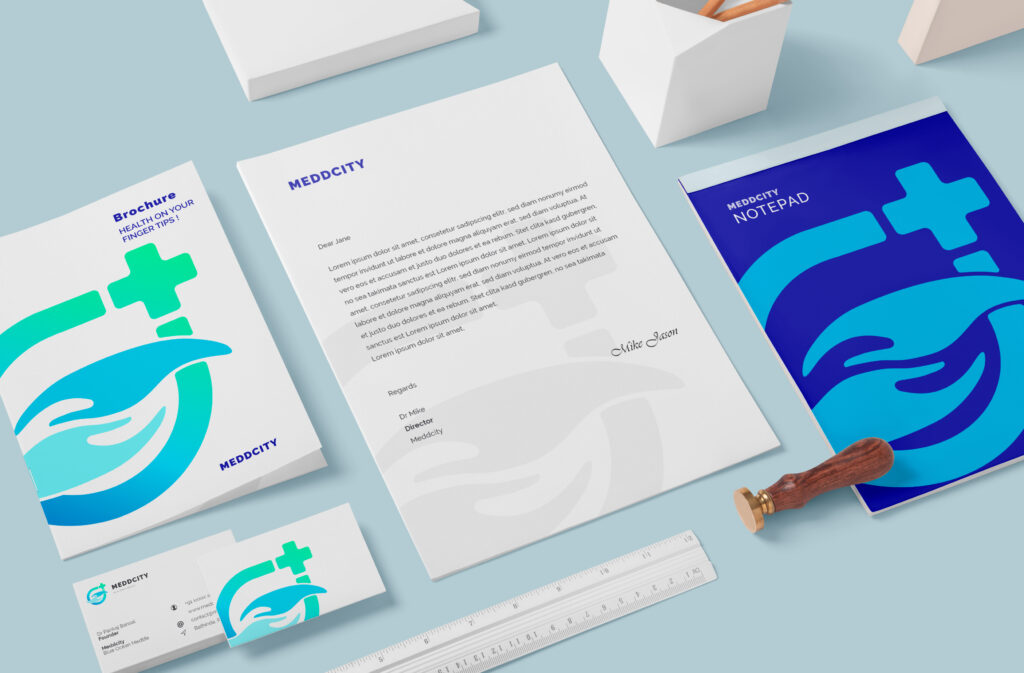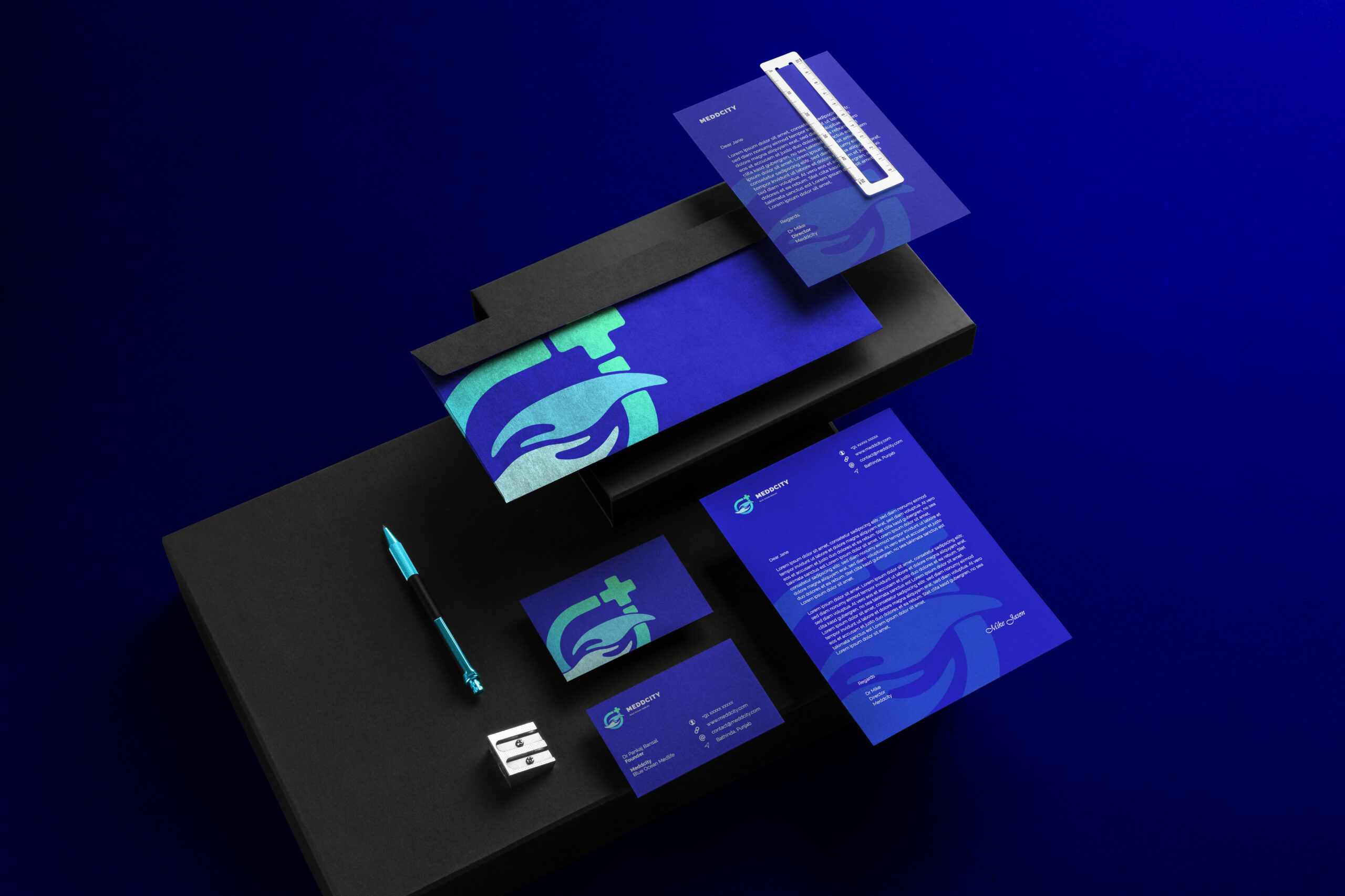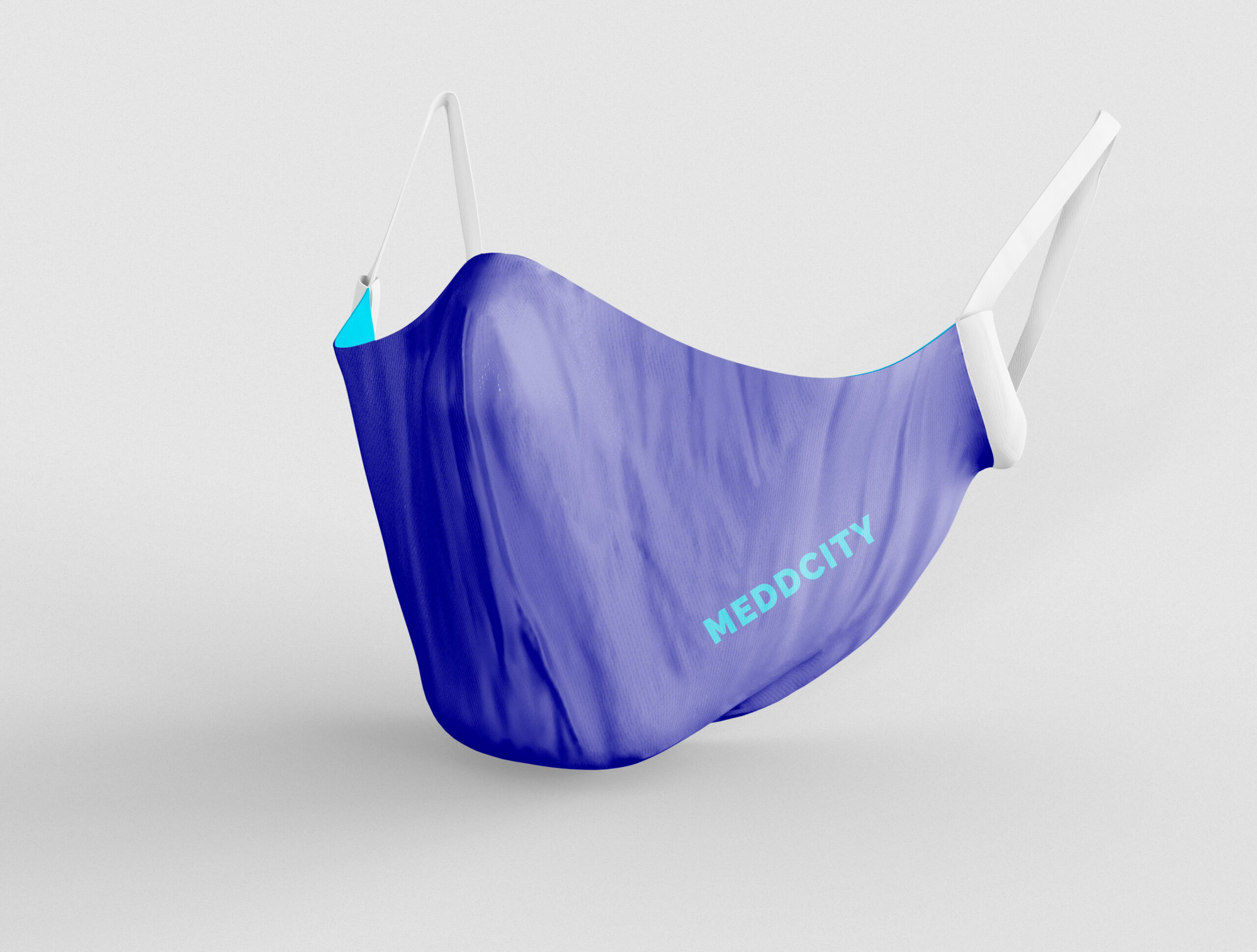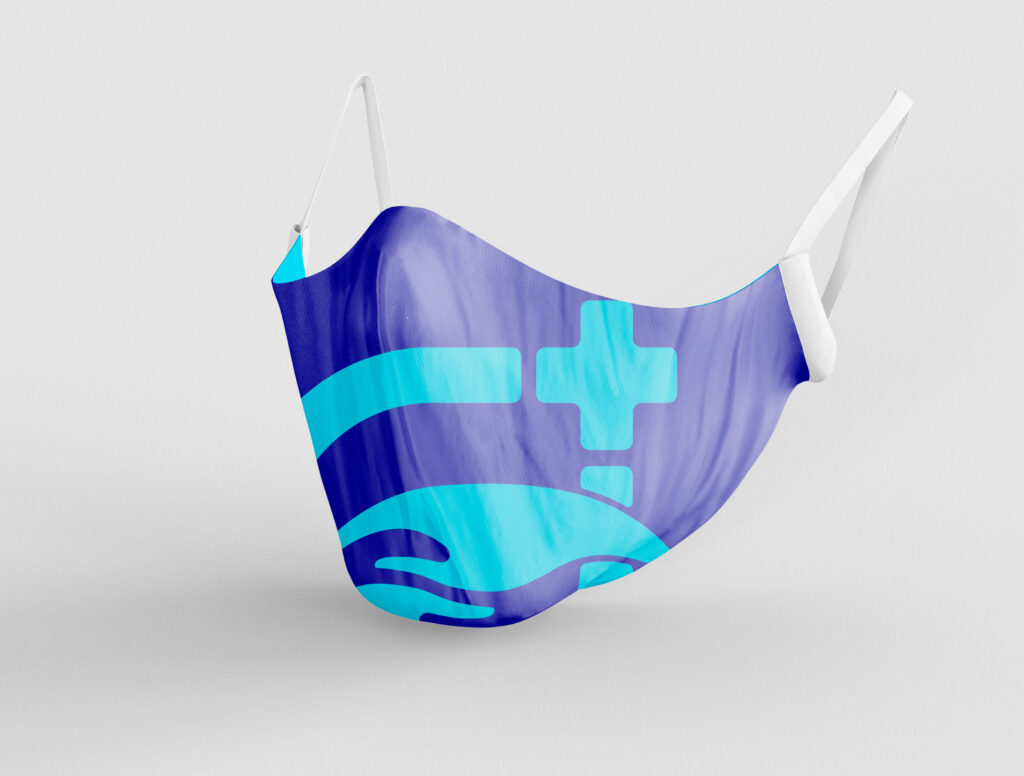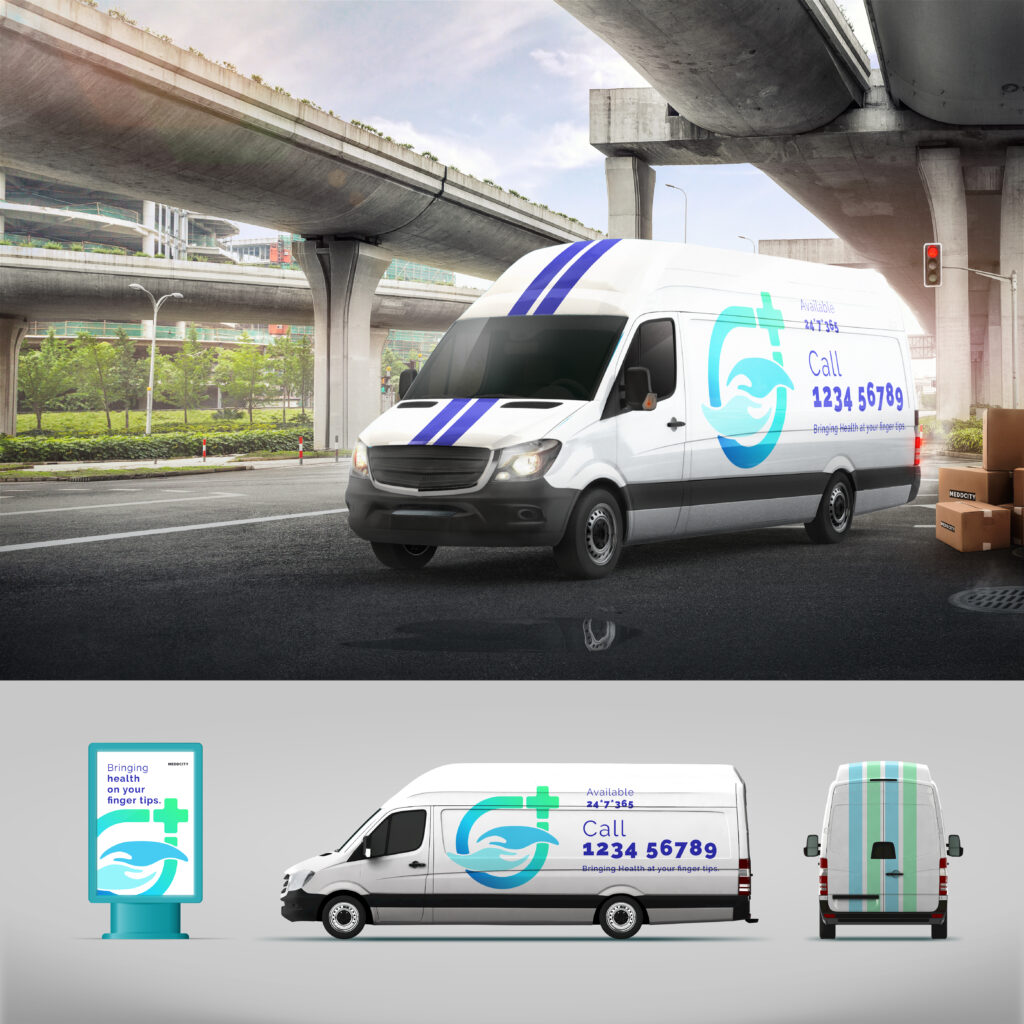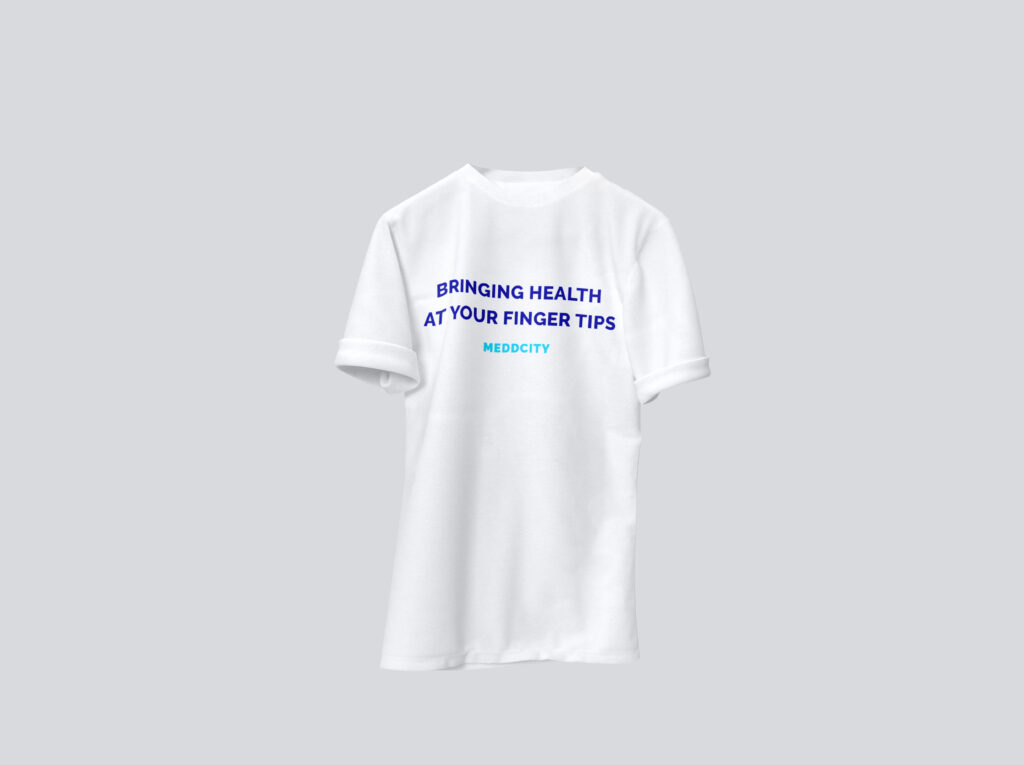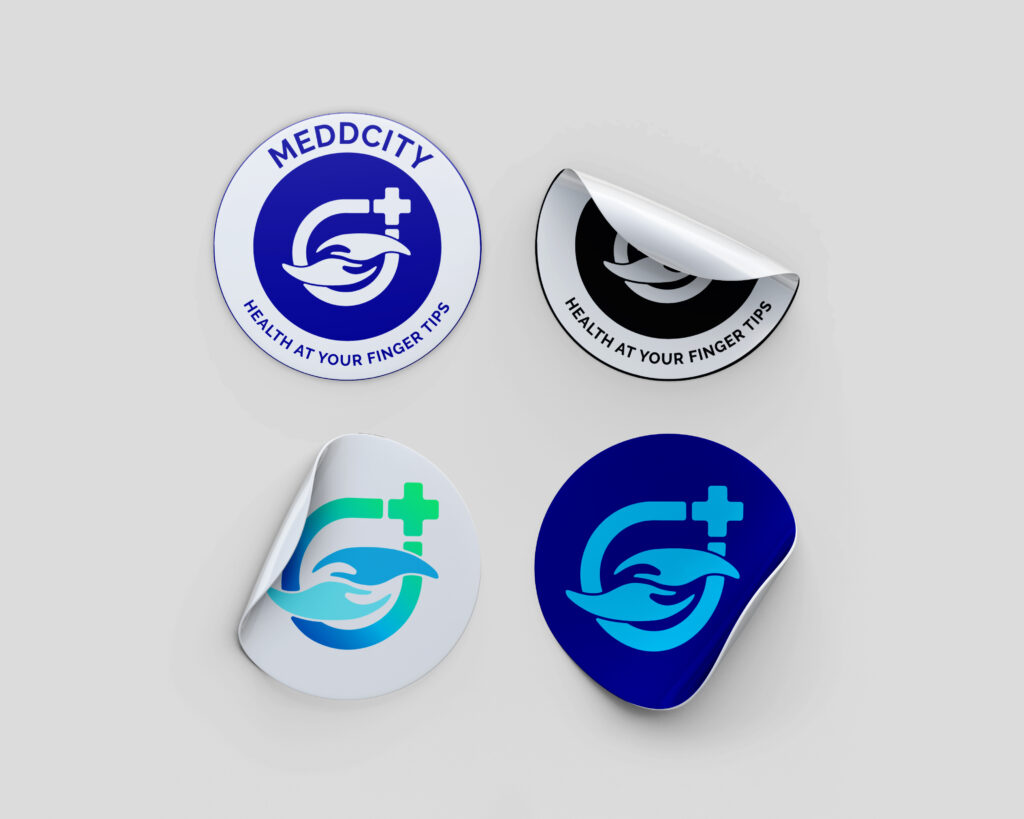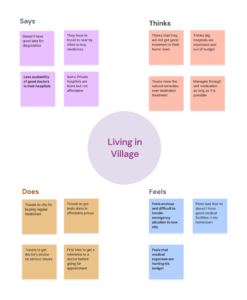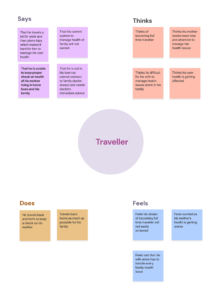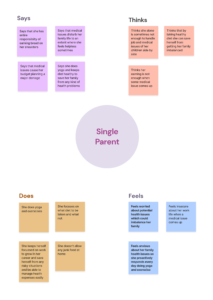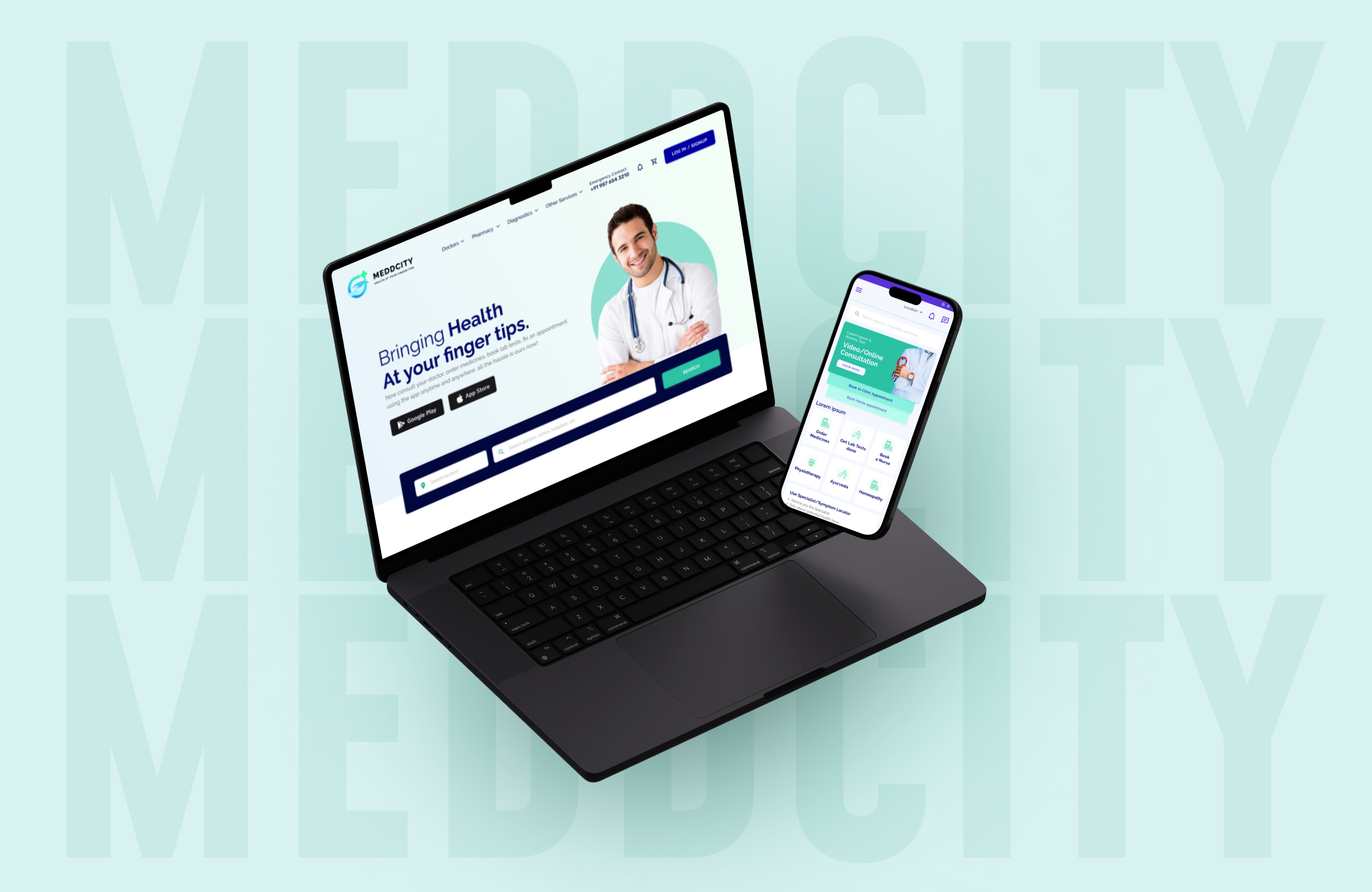
Case study: Meddcity - Branding, Web/App design, UX research
Designer
Harnoor Bhullar
User Experience Research Insights
The core issue identified is the need to make trustworthy healthcare facilities more financially accessible and to provide instant consultation for people living in remote areas. The goal is to revolutionize the healthcare industry by bringing it online, ensuring that everyone, regardless of their location, can access quality medical advice and services.
Understanding the Problem
In the modern era, many daily activities have transitioned online, significantly easing everyday life. However, healthcare has not yet fully embraced this digital transformation. The potential benefits of bringing healthcare online are immense, from saving travel costs for remote patients to providing immediate consultation in emergencies. The need for an efficient online healthcare system is further emphasized by the current limitations faced by existing services.
- Limited Accessibility: Current online healthcare systems like Practo, 1mg, MediBuddy, and Lybrate are primarily accessible in metropolitan areas.
- Disorganized Systems: Many hospitals offer online consultations but lack a structured system, restricting patients to specific hospitals.
- Emergency Response: Lack of immediate access to medical advice in emergencies can be life-threatening.
- Misleading Beliefs: Myths and misconceptions about health persist due to a lack of reliable information.
- Reactive Healthcare: People generally seek medical help only during emergencies or for major health issues.
- Remote Struggles: Areas like Leh Ladakh face significant healthcare challenges due to distance from medical facilities.
- Specialist Access: Patients often need to travel long distances to consult specialists, incurring high travel costs.
- Elderly Challenges: Elderly people living alone struggle with managing medications and doctor appointments.
- Diagnostic Confusion: Diagnostic labs vary in quality and pricing, causing confusion for patients.
- Single Parent Struggles: Single parents face logistical challenges in managing healthcare for themselves and their children.
- Record Misplacement: Patients often misplace medical records and lab reports.
- Specialist Identification: Difficulty in identifying the right specialist for specific health issues.
- Alternative Medicine Access: Access to practitioners of alternative medicine is limited.
- Insurance Awareness: Lack of awareness about health insurance plans and benefits.
- Doctor Switching: Financial and travel constraints hinder switching doctors.
- Home Care Professional Availability: Difficulty in finding home care professionals.
- Home Visits: Uncertainty about the possibility of booking doctors for home visits.
- Pandemic Challenges: Lockdowns during COVID-19 highlighted the need for continuous medication without travel.
- Hospital Bed Availability: Difficulty in finding available hospital beds during emergencies like COVID-19.
About the Users
- Young Population from Cities: Tech-savvy and can easily navigate online healthcare systems.
- Young Population from Remote Villages: Quick learners but may lack access to technology.
- Old Age Population from Cities: Have access to technology and can be guided by family members.
- Old Aged Population from Remote Villages: Limited access to technology and require ongoing support.
- Single Parents: Face logistical challenges and need efficient healthcare solutions.
- Elderly People Living Alone: Need systems for medication management and remote consultations, potentially with family support.
Assumptions About the Industry
- Emerging Online Platforms: The rise of online healthcare platforms.
- Post-COVID Necessity: The pandemic has underscored the need for online healthcare.
- Connectivity Struggles: Current systems face delays and high costs.
- Consultation Costs: High and unpredictable consultation fees.
- Diagnostic Lab Variability: Inconsistent pricing and quality among diagnostic labs.
- Healthcare Equipment Access: Challenges in finding affordable, quality healthcare equipment for professionals.
Practo
- Provider Network: 200,000 healthcare providers.
- Appointments: 50 million appointments in 2020.
- Global Reach: Used in India, Malaysia, Singapore, Indonesia, etc.
- Doctor Services: Practo Health Feed, Practo Pro App, Practo Consult, and Practo Profile.
- Clinic Services: Ray by Practo, Practo Prime, and Practo Reach.
- Hospital Services: Practo Profile, Practo Prime, Practo Reach, Querent by Practo, Insta by Practo, and Qikwell by Practo.
- SAAS for Doctors: Practo Ray for maintaining medical records.
- Visibility Enhancement: Practo Reach enhances the visibility of healthcare professionals, accounting for 40% of market revenue in India.
- Expand Accessibility: Extend services to remote areas and smaller towns.
- Structured Online Consultations: Develop a well-organized system connecting patients with doctors across various hospitals.
- Emergency Support: Implement a system for immediate online consultations during emergencies.
- Myth-Busting: Provide reliable health information to counteract myths.
- Proactive Healthcare: Encourage regular health check-ups and preventive care.
- Remote Area Focus: Special attention to areas with scarce healthcare facilities.
- Specialist Networks: Build a network of specialists available for online consultation.
- Elderly Support: Develop systems for medication management and remote consultations for the elderly.
- Standardized Diagnostics: Create a platform to compare diagnostic labs based on quality and pricing.
- Support for Single Parents: Offer logistical support for single parents managing healthcare.
- Digital Records: Ensure secure and accessible digital storage of medical records.
- Specialist Directory: Provide a comprehensive directory of specialists.
- Alternative Medicine: Include practitioners of alternative medicine in the network.
- Insurance Guidance: Offer information and assistance on health insurance plans.
- Easy Doctor Switching: Facilitate switching doctors with minimal cost and effort.
- Home Care Services: Connect users with home care professionals.
- Home Visit Bookings: Enable easy booking of doctors for home visits.
- Pandemic Preparedness: Ensure continuity of care during emergencies like pandemics.
- Real-Time Bed Availability: Provide real-time information on hospital bed availability.
Target Audience
To maintain focus during primary research, we defined our target audience:
- Age Group: 18+
- Gender Ratio: 50:50
- Occupation: Students, working professionals, senior citizens, single parents, doctors, pharmacists, diagnostic lab technicians, and people migrating due to work.
To deeply understand the pain points and expectations, we conducted extensive user interviews.
Users’ Stories
Jyoti, 25, System Engineer, Ropar:
- Migrated for a job, struggles with homesickness and health management.
- Difficulty finding homoeopathic practitioners in new cities.
- Suggests a one-dial emergency service for instant doctor connections and ambulance arrangements.
- Prefers homeopathy and struggles with timely appointments due to busy schedules.
Tanisha, 24, System Engineer, Noida:
- Faced challenges managing health in a new city.
- Relies on known hospital brands for trust.
- Experiences better healthcare in the new city compared to home.
- Uses online platforms like Practo and 1mg for consultations and medicine orders.
Ananya, 23, Software Developer, Bathinda:
- Relies on recommendations and online reviews for new doctors.
- Prefers staying connected with her family doctor for continuity.
- Struggles with long-distance travel for specialized treatments.
Ajay Singh Rajput, 27, Freelancer, Winnipeg:
- Relies on Canada’s health system, which offers comprehensive care and home visits.
- Prefers face-to-face consultations and finds online consultations unsatisfactory.
Aman Aggarwal, 26, Graphic Designer, Bilaspur:
- Faces challenges with local healthcare availability and affordability.
- Needs reliable online consultations, especially in emergency situations.
Doctors’ Stories
- Dr. Ravi Kumar:
- Faces issues with listing and verification on platforms like Practo.
- Struggles with patient no-shows and managing follow-ups.
- Needs better support for practice setup and patient management.
Pharmacists’ Stories
- Anil, Pharmacist:
- Faces frequent stock shortages.
- Sees potential in home delivery services to enhance business.
- Needs a platform to streamline operations and improve patient service.
Diagnostic Technicians’ Stories
- Sunita, Diagnostic Lab Technician:
- Struggles with maintaining transparency and managing patient records.
- Seeks improved online frameworks for service exposure and patient satisfaction.
Armed with these insights, Meddcity set out to build a reliable, trustworthy, and transparent healthcare platform. Here’s how:
- Expanding Reach: We ensured our services were accessible beyond metropolitan areas, including remote villages.
- Emergency Support: Developed a system for immediate online consultations during emergencies, potentially saving lives.
- Digital Records: Implemented secure, easily accessible digital storage for medical records, reducing the risk of misplaced documents.
- Verified Specialists: Built a network of thoroughly verified specialists and alternative medicine practitioners.
- Quality Assurance: Established rigorous checks on the quality of service provided by doctors, pharmacies, diagnostics, and healthcare assistants.
- Transparent Diagnostics: Created a platform to compare diagnostic labs based on quality and pricing, helping users make informed choices.
- Insurance Guidance: Offered information and assistance on health insurance plans, making it easier for users to navigate their options.
- Efficient Support: Designed a system for real-time issue resolution, ensuring users could connect with a real person when needed.
- Refund Transparency: Developed a transparent refund system, keeping users informed just like tracking a package.
- Fraud Alerts: Enabled immediate fraud alerts, ensuring prompt assistance and resolution.
Hypothesis 1
We need to design a trustworthy, reliable, and transparent online healthcare consultation/appointment service with verified doctors and a system to check the satisfaction of the outcome of consultation.
- Validation: Users have lost trust in existing platforms.
- Sources: Primary and Secondary Research.
Hypothesis 2
We need to design a reliable framework for users to buy medicines online and get them delivered within 2 hours.
- Validation: Existing platforms delivered fake medicines.
- Sources: Primary and Secondary Research.
Hypothesis 3
We need to provide a reliable system for Meddcity users to compare and book test packages online.
- Validation: Users faced misleading reports from diagnostics.
- Sources: Secondary Research.
Hypothesis 4
We need a system that allows patients and doctors to connect with a real person for troubleshooting if automated help fails.
- Validation: Users feel stuck with existing platforms.
- Sources: Secondary Research.
Hypothesis 5
We need a system to ensure quality service from doctors, pharmacies, diagnostics, and healthcare assistants.
- Validation: Existing platforms struggle with quality control.
- Sources: Secondary Research.
Hypothesis 6
We need a system to manage health records and follow-ups to prevent misplacement and missed appointments.
- Validation: Users often misplace records and forget follow-ups.
- Sources: Primary Research.
Hypothesis 7
We need a system for single parents, children managing parents’ health remotely, and elderly individuals to manage their medication.
- Validation: These groups need support in managing health.
- Sources: Primary Research.
Hypothesis 8
We need a proper refund system with tracking, similar to package delivery tracking.
- Validation: Users struggle to receive refunds.
- Sources: Secondary Research.
Hypothesis 9
We need a system to raise fraud alerts for immediate assistance.
- Validation: Users faced significant trouble without timely help.
- Sources: Secondary Research.
Hypothesis 10
We need a system to report unethical behavior by stakeholders to maintain platform integrity and user mental health.
- Validation: Such behavior degrades platform reputation and user trust.
- Sources: Secondary Research.
Hypothesis 11
We need an advanced framework to help doctors/clinics/hospitals set up practice, including medical equipment and patient connections.
- Validation: New practitioners face challenges in setup and patient acquisition.
- Sources: Primary Research.
Hypothesis 12
We need a system for home care and doctor visits as daily travel to clinics/hospitals is not always feasible.
- Validation: Users expressed the need for home visits.
- Sources: Primary Research.
Brand Design
Brand Personality
1. Modern
2. Professional
3. Classic
Based on above characterstics, many ideas were designed from which following concept was chosen as brand logo for, Blue Ocean Medlife’s brand meddcity.
